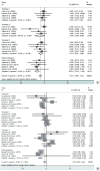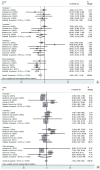A meta-analysis of exposure to particulate matter and adverse birth outcomes
- PMID: 26796890
- PMCID: PMC4722965
- DOI: 10.5620/eht.e2015011
A meta-analysis of exposure to particulate matter and adverse birth outcomes
Abstract
Objectives: The objective of this study was to conduct a systematic review to provide summarized evidence on the association between maternal exposure to particulate air pollution and birth weight (BW) and preterm birth (PTB) after taking into consideration the potential confounding effect of maternal smoking.
Methods: We systematically searched all published cohort and case-control studies examining BW and PTB association with particulate matter (PM, less than or equal to 2.5μm and 10.0 μm in diameter, PM2.5 and PM10, respectively) from PubMed and Web of Science, from January 1980 to April 2015. We extracted coefficients for continuous BW and odds ratio (OR) for PTB from each individual study, and meta-analysis was used to combine the coefficient and OR of individual studies. The methodological quality of individual study was assessed using a standard protocol proposed by Downs and Black. Forty-four studies met the inclusion criteria.
Results: In random effects meta-analyses, BW as a continuous outcome was negativelyassociated with 10 μg/m(3) increase in PM10 (-10.31 g; 95% confidence interval [CI], -13.57 to -3.13 g; I-squared=0%, p=0.947) and PM2.5 (-22.17 g; 95% CI, -37.93 to -6.41 g; I-squared=92.3%, p <0.001) exposure during entire pregnancy, adjusted for maternal smoking. A significantly increased risk of PTB per 10 μg/m(3) increase in PM10 (OR, 1.23; 95% CI, 1.04 to 1.41; I-squared=0%, p =0.977) and PM2.5 (OR, 1.14; 95% CI, 1.06 to 1.22; I-squared=92.5%, p <0.001) exposure during entire pregnancy was observed. Effect size of change in BW per 10 μg/m(3) increase in PM tended to report stronger associations after adjustment for maternal smoking.
Conclusions: While this systematic review supports an adverse impact of maternal exposure to particulate air pollution on birth outcomes, variation in effects by exposure period and sources of heterogeneity between studies should be further explored.
Keywords: Birth weight; Heterogeneity; Maternal smoking; Meta-analysis; Particulate matter; Preterm birth.
Conflict of interest statement
The authors have no conflicts of interest associated with material presented in this paper.
Figures





References
-
- Sapkota A, Chelikowsky AP, Nachman KE, Cohen AJ, Ritz B. Exposure to particulate matter and adverse birth outcomes: a comprehensive review and meta-analysis. Air Qual Atmos Health. 2012;5(4):369–381.
-
- Stieb DM, Chen L, Eshoul M, Judek S. Ambient air pollution, BW and preterm birth: a systematic review and meta-analysis. Environ Res. 2012;117:100–111. - PubMed
-
- Behrman RE, Butler AS. Committee on Understanding Premature Birth and Assuring Healthy Outcomes. Preterm birth: causes, consequences, and prevention. Washington, DC: National Academies Press; 2007. pp. 311–432. - PubMed
-
- Wilcox AJ. On the importance--and the unimportance--of birthweight. Int J Epidemiol. 2001;30(6):1233–1241. - PubMed
Publication types
LinkOut - more resources
Full Text Sources
Other Literature Sources
Miscellaneous

